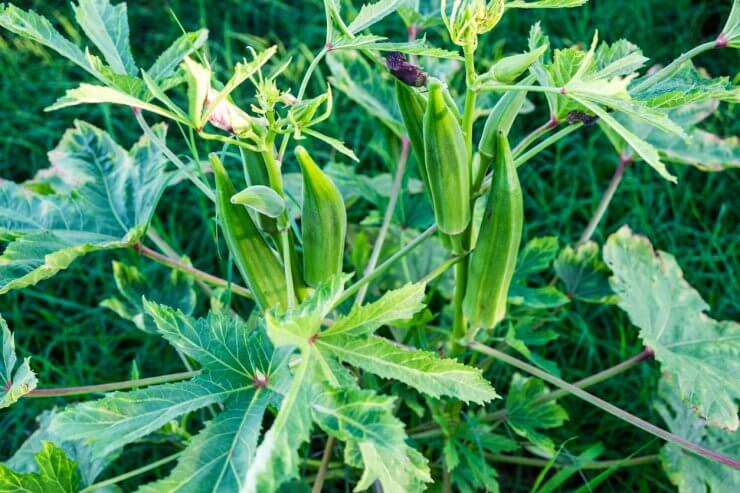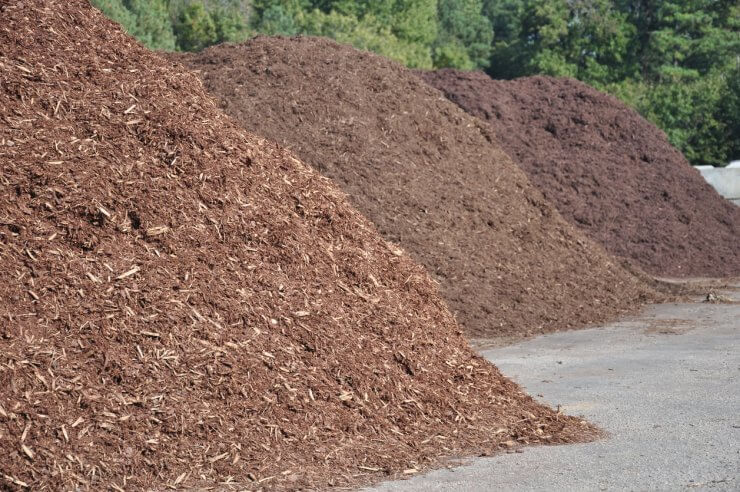
Healthy okra plants
Like all food crops, okra is susceptible to various fungal diseases. Your best weapons against these are best planting practices, which help prevent disease in the first place.
This is especially important as there are no fungicides approved for home use for many diseases.
These best practices are aimed at producing strong, healthy plants that can withstand disease, and at avoiding situations that contribute to the development of disease. They involve keeping plants clean, dry, and undamaged.
Watering: Avoid getting leaves wet by using a drip system or soaker hose. If you must use a sprinkler system or a garden hose, water plants in the morning on a sunny day to allow leaves to dry quickly.
Site/crop rotation: Site rotation is a general best practice to help reduce the effects of soil-borne diseases. A good rule of thumb is to wait at least three years before you plant the same crop in the same place. Crop rotation will give the soil some R&R—rest and replenishment. Planting different crops from one growing season to the next can help restore the balance in the soil: for example, some crops are heavy nitrogen feeders, while others are heavy nitrogen producers. After okra, you could plant onions or garlic; the next year, tomatoes, peppers, or potatoes; the year after that, something from the brassica family (cabbage, kale, broccoli); then go back to okra. Now, if you’re doing container gardening or even gardening in raised beds, you can (and should) do a complete soil replacement with every new planting season.
Solarization: If you can sacrifice the growing space, solarization can help eradicate many soil-borne pests and diseases. But it means taking that section of your garden out of commission for at least a season. You’re going to enlist the sun’s help to help clean your soil. Clear the affected garden bed. Dig a trench around the perimeter of the bed, 8 to 12 inches deep and 12 inches wide. Keep that soil set aside. Moisten the garden bed soil; this will help with heat retention. Spread a sheet of clear plastic (1 to 2 millimeters thick) over the garden bed, draping the edges into the trench. Fill in the trench, pulling the plastic taut as you go. The tighter the fit, the better heat retention you’ll get.
Leave the plastic in place for four to six weeks. At the end of that time, most of the soil-borne pests and diseases should be “cooked” out of the soil, and the heat will have activated nutrients in the soil. If you can’t afford all that down time for the garden bed, try this method for four to six weeks in the spring and again after your harvest.
Mulch: Since okra is an annual plant, you’ll only use mulch as needed for water retention and weed suppression.

Mulch to suppress weeds and retain water
Other best practices include:
- Buying healthy, disease-free plants or reliable seeds from reputable sources
- Planting in full sun
- Planting in sites with good drainage, and adding compost to improve drainage
- Keeping plants from becoming too crowded
- Removing weeds to improve air circulation
- Planting in rows to promote good air movement around plants
- Harvesting frequently and remove any infected plants and pods
- Handling pods with care, refrigerating soon after picking, and cooking, canning, drying, or freezing the pods within a few days of harvest
Common okra diseases
Here are some of the diseases that can wreak havoc with your okra plants. Remember to remove and destroy (not compost, never compost) any infected plants. The short story on protecting your okra plants from many of these diseases: don’t overdo it on the watering. You can kill your crops with kindness, so be mindful.
Cercospora Leaf Spot: If you see spots on your okra leaves, they could be the result of any number of organisms. Cercospora is a fungal infection that can be carried on the wind from one infected plant to another. The most common time for infections to spread is after a rainy spell. The spores stick to the leaves and start growing; you’ll see yellow and brown spots on the underside of the leaves. Left unchecked, the leaves will dry up and turn brown. To keep infection from spreading, remove and discard infected leaves. Don’t ever compost infected plants. Once you’ve removed infected leaves, apply a weekly spray a sulfur or copper-based fungicide on the underside of the leaves in the afternoon, when the air is calm. Although this won’t kill leaf spot, it should prevent the spores from germinating and spreading further. Cercospora survives in the remnants of plants it infects, including eggplant, beets, spinach, and okra.
Damping Off: Microorganisms are everywhere; some of them beneficial, others, not so much. Plants can fall prey to damping off when the environmental conditions are just right for the fungi that cause this disease—cold, wet soil with poor drainage. You can suspect damping off if your seeds fail to germinate or if your seedlings suddenly take a turn for the worse, turning brown and disintegrating. Once one of these fungi (fusarium, phytophthora, pythium, or rhizoctonia) attack your okra, there’s no going back. Throw out the infected plants, and if they were already growing in your garden bed, watch your other plants closely. One strategy is to let the soil dry out completely before you water the plants again.
Enation Leaf Curl: Whiteflies are to blame for carrying this viral disease to okra. Enations (outgrowths) appear on the underside of the leaves, and the leaves turn thick and leathery. The whole plant may appear twisted. You should remove and destroy any plants that develop this infection; there’s no way to save them. Your best defense is to watch for whiteflies and keep them off your plants. Neem oil or a soap spray applied to the underside of your plant’s leaves can kill these nasty pests.
Fusarium Wilt: Fusarium wilt strikes the leaves from the bottom up and usually on one side, making them wilt and turn yellow. This nasty fungal infection is caused by Fusarium oxysporum; its spores can survive in the soil for up to seven years! It thrives in wet and warm conditions, sneaking in through a plant’s root system and moving upward. Destroy infected plants.
Okra Leaf Spot: A lot of organisms can cause spotting on okra plant leaves. Some of them—Alternaria, Ascochyta, and Phyllosticta hibiscina—can cause damage that’s more cosmetic than harmful. These are fungal organisms, and there’s no real way to cure an infection. Remove infected leaves, but if the infection is severe, destroy the plant.
Southern Blight: This is a soil-borne fungus (Sclerotium rolfsii). You’ll notice your plants wilting, with yellowing leaves, a darkened stem, and a white fungal growth at the soil line. Destroy infected plants and treat the soil with a fungicide like Terraclor.
Yellow Vein Mosaic Virus: Whiteflies transmit this nasty disease that attacks okra seedlings. The veins in the plant’s leaves will turn thick and yellow, and the plant’s growth will be stunted. And to add insult to injury, any pods the plants do manage to form will likely be deformed. There’s no cure for yellow vein mosaic virus. Your best defense is to be on the lookout for whiteflies and wipe them out when you spot them. Neem oil or soap spray can be effective.
Which diseases have you confronted with your okra? Please tell us how you prevent and handle diseases.


 Previous
Previous


Fruit has on bumps